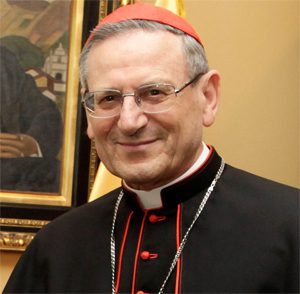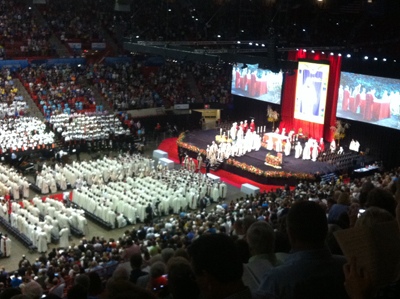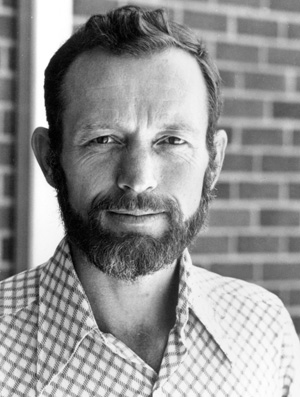 The Beatification of Father Stanley Rother of Oklahoma, the first native-born American Martyr, occurred Saturday September 23 in Oklahoma City. The ceremony was the largest Catholic service in the history of the State of Oklahoma, taking place in the Cox Convention Center which filled to capacity of 15,000 with substantial overflow outside the arena.
The Beatification of Father Stanley Rother of Oklahoma, the first native-born American Martyr, occurred Saturday September 23 in Oklahoma City. The ceremony was the largest Catholic service in the history of the State of Oklahoma, taking place in the Cox Convention Center which filled to capacity of 15,000 with substantial overflow outside the arena.

Cardinal Amato, Prefect for the Causes of Saints
The service was presided over by the Cardinal Angelo Amato, Prefect for the Congregation for the Causes of Saints who served as Pope Francis’s representative to the service, and concelebrated by Archbishop Paul Coakley of Oklahoma City, Archbishop Emeritus Eusebius Beltran of Oklahoma City, Bishop David Konderla of Tulsa, Bishop Emeritus Edward Slattery of Tulsa, and Bishop Gonzalo de Villa y Vasquez of Solola-Chimaltenango in Guatemala.
The Mass, given the size of the event, ran extremely well, even from the vantage point in the rafters. I had arrived early before the doors opened at 8 AM, and still had to sit far away from the stage.
Though I am not Catholic, I attended in the stead of friends and family members who could not. It was a historical event foolish to pass up and great to witness.
 Blessed Stanley Rother was born on March 27, 1935 in Okarche during the heart of the Dust Bowl and Great Depression. The town was founded during the landrun by German immigrants who were either Catholic and Lutheran in the 1890s. Growing up during the Depression and later World War II left a lasting imprint on Rother. After high school he felt drawn by his spirit to a vocation as a priest, similar to the vocation his sister Marita (who is still living) undertook as a nun in the mid-1950s. At seminary in San Antonio, he struggled mightily with Latin. He consulted with then Bishop Victor Reed, who sent him to Mount Saint Mary’s Seminary in Emmittsburg, Maryland, where he finally graduated in 1963.
Blessed Stanley Rother was born on March 27, 1935 in Okarche during the heart of the Dust Bowl and Great Depression. The town was founded during the landrun by German immigrants who were either Catholic and Lutheran in the 1890s. Growing up during the Depression and later World War II left a lasting imprint on Rother. After high school he felt drawn by his spirit to a vocation as a priest, similar to the vocation his sister Marita (who is still living) undertook as a nun in the mid-1950s. At seminary in San Antonio, he struggled mightily with Latin. He consulted with then Bishop Victor Reed, who sent him to Mount Saint Mary’s Seminary in Emmittsburg, Maryland, where he finally graduated in 1963.
After graduation, he served in several parishes across Oklahoma during the mid-1960s, including Saint Francis Xavier and Holy Family Cathedral in Tulsa. He was not satisfied with his assignments in Oklahoma, however, and asked Bishop Reed for reassignment to the relatively new Oklahoma Mission in Santiago Atitlan in Guatemala. It had been established by the Diocese of Oklahoma City-Tulsa during the Second Vatican Council in response to Pope Saint John XXII’s admonition to Catholics in the First World to begin new mission and evangelization efforts in areas less fortunate than the circumstances they themselves lived. It would be an assignment Fr. Rother undertook with gusto, but which would ultimately end his mortal life.
 While in Guatemala, Rother led the building of a new hospital, cleared land for farming, built an irrigation system for those local farmers and served as a teacher not just of Catholicism but general literacy in Spanish and Tz’utujil to his parishioners. Most importantly, Rother translated the New Testament into Tz’utujil for the locals to more easily understand the teachings of Christ.
While in Guatemala, Rother led the building of a new hospital, cleared land for farming, built an irrigation system for those local farmers and served as a teacher not just of Catholicism but general literacy in Spanish and Tz’utujil to his parishioners. Most importantly, Rother translated the New Testament into Tz’utujil for the locals to more easily understand the teachings of Christ.
He also helped in efforts to recover from the earthquake that struck the country in 1976. His work led him to becoming the de facto head of the mission by the mid-1970s, and he would guide those who came from Oklahoma to help as only he could. This also led to him becoming one of the pillars of the local community in Santiago Atitlan.
For most of Rother’s time there, the area was peaceful as events of the civil war were mostly confined to the cities. By the late 1970s, though, the activities of both the communist rebels and military had spread to his area. The ramifications, especially from the government became immediately apparent. A meeting was held after military occupation began, and at the meeting between the local populace and military leaders, the military declared that they were in the area to protect the local populace. Father Rother immediately raised his hand and asked, “If that is why you are here, then why have some of my catechists and parishioners gone missing or have been found dead with no explanation?”
This drew immediate ire from the military, who for several years conducted a campaign against what they perceived as communist influence within the church and support for the rebels, with liberation theology (a heresy as declared by the Catholic Church itself) providing a religious basis for resistance to the regime. They viewed Rother as an immediate threat, and over the course of 1980 trashed the radio station he built, and kept up pressure on the mission. By the end of the year, he had been put on the government’s official hit list for the area, and was told by parishioners aware that he had to flee for his own safety. At the start of 1981 he left for Oklahoma, but temporarily.

Father Stanley Rother
Father Rother was unhappy back in Oklahoma, and felt a constant pull to go back for almost four months. He asked then-Archbishop Charles Salatka to go back, and the Archbishop agreed reluctantly for his return in time for Holy Week that April. His brother Tom asked why would he go back knowing the risks, and Father Stanley replied: “Well, a shepherd cannot run from his flock.” He responded to a Carmelite nun who asked what to do if should be killed: “Raise the standard of Christ Risen.” He came back to Oklahoma shortly once more in May of 1981 for his cousin’s (Rev. Don Wolf, who is still living) ordination, but then went to Guatemala for the last time.
In the early morning hours of July 28, 1981, three masked gunmen stormed the rectory of the parish where Father Rother had started taking refuge after his return. Two shots were fired, killing him instantly. The three men ran into night, and they nor anyone else were never brought to official justice; the murder has never been solved. He was on of ten priests killed that year by the government and its paramilitary forces. In the aftermath, the entire village came out to clean up the scene, and collected his blood in mason jars for preservation; they knew he was a martyr immediately. Knowing how much he meant to the area’s people, an agreement was reached between the family and the people of Santiago Atitlan: His body would return to the US to be buried in Okarche, but his heart would remain in the town, and would be interred under the altar of the church where he served for the past thirteen years. In the years to come the drumbeat began for official recognition of his martyric death.
In 2007, then-Archbishop Beltran began the process of opening the cause for Father Rother’s canonization, with the process led by Postulator Dr. Andrea Ambrosi. Working with the diocese of Solola-Chimaltenango. The investigation took three years from 2007 to 2010, during which Pope Benedict XVI declared Rother a Servant of God in 2009. The process worked its way through the Congregation for the Causes of Saints over that time, and was given the Papal seal of approval in December 2016, allowing him to be declared Venerable. Shortly thereafter, the date for his declaration as Beati, or Blessed, was made in March of this year, and made official Saturday. As Rother had died a martyr “in odium fidei”, it was not necessary for him to have a miracle associated with his cause to be ranked among the Blessed.
 I note that after the Apostolic Letter was read declaring him Blessed, the cloth banner of him in his priestly vestments, bordered in Mayan patterns, with an image of the mission building he presided over in the top right corner was unveiled to great applause, and was beautifully made.
I note that after the Apostolic Letter was read declaring him Blessed, the cloth banner of him in his priestly vestments, bordered in Mayan patterns, with an image of the mission building he presided over in the top right corner was unveiled to great applause, and was beautifully made.
The documentary at the start of service did an admirable job conveying his story. and should be required viewing for those who want to know it. With his body exhumed, a shrine is to be built in Oklahoma City in his honor. A rib was taken from his body, and along with his heart in Guatemala are first class relics which will be venerated by the Catholic faithful in perpetuity as they are spread around the world. For now, his public veneration in churches, by Canon Law, is limited to the United States and Guatemala on the date of death, July 28. It is with that in mind that Archbishop Coakley stated in the closing of the Mass that much had been accomplished, but much is left to be done, as he still will need a miracle to be declared officially a Saint that can be commemorated the world over.
It is not lost on this writer that Oklahoma is one of the most anti-leftist areas in the country, and a good argument can be made possibly the world over. This makes it all the more interesting the Blessed Father Stanley Rother was killed in response to a rabidly anti-leftist government. He undoubtedly had sympathies for the views of the rebels, as he saw the destitution of the areas he oversaw first hand where the elites of Guatemala almost totally ignored them. That said, to any who would question whether he was actually orthodox in his practice and not succumbed in heretical teaching should look to the parish he presided over now, 36 years later. Sixteen years ago, Oklahoma’s role in the Mission in Santiago Atitlan closed, as the local diocese there had finally enough manpower to run it alone. More importantly, in fulfillment of what Tertullian said that from the blood of martyrs blossoms the souls of new Christians, his parish in Santiago
Atitalan, a parish that was over 400 years old when he arrived and had NEVER had a spiritual vocation arise from it in that time, has had nine priests go through seminary since he passed, with eight more in training now. If that is not testament to his true faith, I don’t know what is.
As a young Oklahoman in the present day, many from my hometown of Claremore, and numerous cities and towns across the country, feel that they have no ability to effect meaningful change in their own lives, much less those of others, in either a spiritual realm or more secular one. I would say to them, and to myself, that Father Rother is a perfect example of how wrong that thinking really is.
He came from a totally normal background like millions of others of his time, but he chose a path to make a difference to tens of thousands in an area of the world ignored by virtually everyone who materially “mattered”, and made a thriving community out of virtually nothing.
It is not a conventional path by any means, but his story can be viewed as a fulfillment of the American Dream, but in a much more spiritual sense. Eastern Orthodoxy also has a similar story in Seraphim Rose, who though had different path in getting there, came from conventional beginnings in modern day America to make a big difference in the modern day for many multiple thousands. I would tell Americans of my generation, the Millennials, even from non-Catholic or -Orthodox backgrounds, to not give up hope that they can make a difference. You can discern a path for success, either in this world, or in the next.
The Collect for Blessed Stanley Rother:
O God,
who gave your priest Blessed Stanley
the heart of a pastor and the fidelity of a martyr,
grant, through his intercession,
that the humble flock may reach
where the brave Shepherd has gone before.
Who lives and reigns with you in the unity of the Holy Spirit,
one God, forever and ever.
Amen.
